
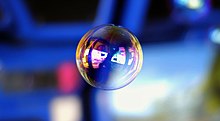
A bubble is a globule of a gas substance in a liquid. In the opposite case, a globule of a liquid in a gas, is called a drop. [1] Due to the Marangoni effect, bubbles may remain intact when they reach the surface of the immersive substance.


A bubble is a globule of a gas substance in a liquid. In the opposite case, a globule of a liquid in a gas, is called a drop. [1] Due to the Marangoni effect, bubbles may remain intact when they reach the surface of the immersive substance.
Bubbles are seen in many places in everyday life, for example:
Bubbles form and coalesce into globular shapes because those shapes are at a lower energy state. For the physics and chemistry behind it, see nucleation.
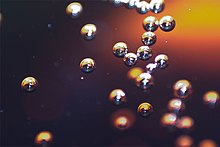
Bubbles are visible because they have a different refractive index (RI) than the surrounding substance. For example, the RI of air is approximately 1.0003 and the RI of water is approximately 1.333. Snell's Law describes how electromagnetic waves change direction at the interface between two mediums with different RI; thus bubbles can be identified from the accompanying refraction and internal reflection even though both the immersed and immersing mediums are transparent.
The above explanation only holds for bubbles of one medium submerged in another medium (e.g. bubbles of gas in a soft drink); the volume of a membrane bubble (e.g. soap bubble) will not distort light very much, and one can only see a membrane bubble due to thin-film diffraction and reflection.
Nucleation can be intentionally induced, for example, to create a bubblegram in a solid.
In medical ultrasound imaging, small encapsulated bubbles called contrast agent are used to enhance the contrast.
In thermal inkjet printing, vapor bubbles are used as actuators. They are occasionally used in other microfluidics applications as actuators. [2]
The violent collapse of bubbles (cavitation) near solid surfaces and the resulting impinging jet constitute the mechanism used in ultrasonic cleaning. The same effect, but on a larger scale, is used in focused energy weapons such as the bazooka and the torpedo. Pistol shrimp also uses a collapsing cavitation bubble as a weapon. The same effect is used to treat kidney stones in a lithotripter. Marine mammals such as dolphins and whales use bubbles for entertainment or as hunting tools. Aerators cause the dissolution of gas in the liquid by injecting bubbles.
Bubbles are used by chemical and metallurgic engineer in processes such as distillation, absorption, flotation and spray drying. The complex processes involved often require consideration for mass and heat transfer and are modeled using fluid dynamics. [3]
The star-nosed mole and the American water shrew can smell underwater by rapidly breathing through their nostrils and creating a bubble. [4]
Research on the origin of life on Earth suggests that bubbles may have played an integral role in confining and concentrating precursor molecules for life, a function currently performed by cell membranes. [5]
Bubble lasers use bubbles as the optical resonator. They can be used as highly sensitive pressure sensors. [6]
When bubbles are disturbed (for example when a gas bubble is injected underwater), the wall oscillates. Although it is often visually masked by much larger deformations in shape, a component of the oscillation changes the bubble volume (i.e. it is pulsation) which, in the absence of an externally-imposed sound field, occurs at the bubble's natural frequency. The pulsation is the most important component of the oscillation, acoustically, because by changing the gas volume, it changes its pressure, and leads to the emission of sound at the bubble's natural frequency. For air bubbles in water, large bubbles (negligible surface tension and thermal conductivity) undergo adiabatic pulsations, which means that no heat is transferred either from the liquid to the gas or vice versa. The natural frequency of such bubbles is determined by the equation: [7] [8]
where:
For air bubbles in water, smaller bubbles undergo isothermal pulsations. The corresponding equation for small bubbles of surface tension σ (and negligible liquid viscosity) is [8]
Excited bubbles trapped underwater are the major source of liquid sounds, such as inside our knuckles during knuckle cracking, [9] and when a rain droplet impacts a surface of water. [10] [11]
Injury by bubble formation and growth in body tissues is the mechanism of decompression sickness, which occurs when supersaturated dissolved inert gases leave the solution as bubbles during decompression. The damage can be due to mechanical deformation of tissues due to bubble growth in situ, or by blocking blood vessels where the bubble has lodged.
Arterial gas embolism can occur when a gas bubble is introduced to the circulatory system and lodges in a blood vessel that is too small for it to pass through under the available pressure difference. This can occur as a result of decompression after hyperbaric exposure, a lung overexpansion injury, during intravenous fluid administration, or during surgery.

Pressure is the force applied perpendicular to the surface of an object per unit area over which that force is distributed. Gauge pressure is the pressure relative to the ambient pressure.
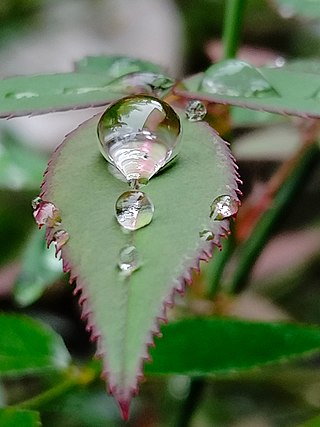
A drop or droplet is a small column of liquid, bounded completely or almost completely by free surfaces. A drop may form when liquid accumulates at the end of a tube or other surface boundary, producing a hanging drop called a pendant drop. Drops may also be formed by the condensation of a vapor or by atomization of a larger mass of solid. Water vapor will condense into droplets depending on the temperature. The temperature at which droplets form is called the dew point.
In physical chemistry, supersaturation occurs with a solution when the concentration of a solute exceeds the concentration specified by the value of solubility at equilibrium. Most commonly the term is applied to a solution of a solid in a liquid, but it can also be applied to liquids and gases dissolved in a liquid. A supersaturated solution is in a metastable state; it may return to equilibrium by separation of the excess of solute from the solution, by dilution of the solution by adding solvent, or by increasing the solubility of the solute in the solvent.

Foams are materials formed by trapping pockets of gas in a liquid or solid.
In thermodynamics, superheating is the phenomenon in which a liquid is heated to a temperature higher than its boiling point, without boiling. This is a so-called metastable state or metastate, where boiling might occur at any time, induced by external or internal effects. Superheating is achieved by heating a homogeneous substance in a clean container, free of nucleation sites, while taking care not to disturb the liquid.

An antibubble is a droplet of liquid surrounded by a thin film of gas, as opposed to a gas bubble, which is a sphere of gas surrounded by a liquid. Antibubbles are formed when liquid drops or flows turbulently into the same or another liquid. They can either skim across the surface of a liquid such as water, in which case they are also called water globules, or they can be completely submerged into the liquid to which they are directed.
In physics and chemistry, flash freezing is the process whereby objects are rapidly frozen. This is done by subjecting them to cryogenic temperatures, or it can be done through direct contact with liquid nitrogen at −196 °C (−320.8 °F). It is commonly used in the food industry.
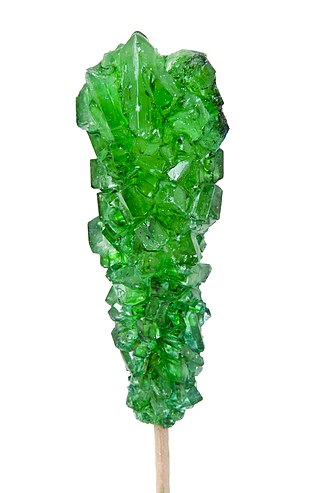
In thermodynamics, nucleation is the first step in the formation of either a new thermodynamic phase or structure via self-assembly or self-organization within a substance or mixture. Nucleation is typically defined to be the process that determines how long an observer has to wait before the new phase or self-organized structure appears. For example, if a volume of water is cooled below 0 °C, it will tend to freeze into ice, but volumes of water cooled only a few degrees below 0 °C often stay completely free of ice for long periods (supercooling). At these conditions, nucleation of ice is either slow or does not occur at all. However, at lower temperatures nucleation is fast, and ice crystals appear after little or no delay.
The Varying Permeability Model, Variable Permeability Model or VPM is an algorithm that is used to calculate the decompression stops needed for ambient pressure dive profiles using specified breathing gases. It was developed by D.E. Yount and others for use in professional diving and recreational diving. It was developed to model laboratory observations of bubble formation and growth in both inanimate and in vivo systems exposed to pressure. In 1986, this model was applied by researchers at the University of Hawaii to calculate diving decompression tables.
The Kelvin equation describes the change in vapour pressure due to a curved liquid–vapor interface, such as the surface of a droplet. The vapor pressure at a convex curved surface is higher than that at a flat surface. The Kelvin equation is dependent upon thermodynamic principles and does not allude to special properties of materials. It is also used for determination of pore size distribution of a porous medium using adsorption porosimetry. The equation is named in honor of William Thomson, also known as Lord Kelvin.
Volatiles are the group of chemical elements and chemical compounds that can be readily vaporized. In contrast with volatiles, elements and compounds that are not readily vaporized are known as refractory substances.
The hot chocolate effect is a phenomenon of wave mechanics in which the pitch heard from tapping a cup of hot liquid rises after the addition of a soluble powder. The effect is thought to happen because upon initial stirring, entrained gas bubbles reduce the speed of sound in the liquid, lowering the frequency. As the bubbles clear, sound travels faster in the liquid and the frequency increases.
In fluid thermodynamics, nucleate boiling is a type of boiling that takes place when the surface temperature is hotter than the saturated fluid temperature by a certain amount but where the heat flux is below the critical heat flux. For water, as shown in the graph below, nucleate boiling occurs when the surface temperature is higher than the saturation temperature by between 10 and 30 °C. The critical heat flux is the peak on the curve between nucleate boiling and transition boiling. The heat transfer from surface to liquid is greater than that in film boiling.

The Minnaert resonance is a phenomenon associated with a gas bubble pulsating at its natural frequency in a liquid, neglecting the effects of surface tension and viscous attenuation. It is the frequency of the sound made by a drop of water from a tap falling in water underneath, trapping a bubble of air as it falls. The natural frequency of the entrapped air bubble in the water is given by

The Laplace pressure is the pressure difference between the inside and the outside of a curved surface that forms the boundary between two fluid regions. The pressure difference is caused by the surface tension of the interface between liquid and gas, or between two immiscible liquids.
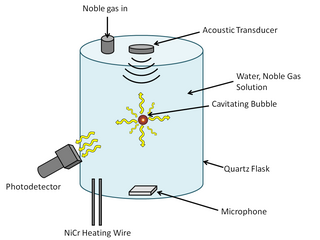
Sonoluminescence is a phenomenon that occurs when a small gas bubble is acoustically suspended and periodically driven in a liquid solution at ultrasonic frequencies, resulting in bubble collapse, cavitation, and light emission. The thermal energy that is released from the bubble collapse is so great that it can cause weak light emission. The mechanism of the light emission remains uncertain, but some of the current theories, which are categorized under either thermal or electrical processes, are Bremsstrahlung radiation, argon rectification hypothesis, and hot spot. Some researchers are beginning to favor thermal process explanations as temperature differences have consistently been observed with different methods of spectral analysis. In order to understand the light emission mechanism, it is important to know what is happening in the bubble's interior and at the bubble's surface.
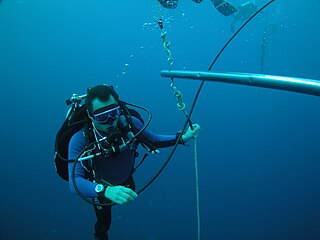
Decompression theory is the study and modelling of the transfer of the inert gas component of breathing gases from the gas in the lungs to the tissues and back during exposure to variations in ambient pressure. In the case of underwater diving and compressed air work, this mostly involves ambient pressures greater than the local surface pressure, but astronauts, high altitude mountaineers, and travellers in aircraft which are not pressurised to sea level pressure, are generally exposed to ambient pressures less than standard sea level atmospheric pressure. In all cases, the symptoms caused by decompression occur during or within a relatively short period of hours, or occasionally days, after a significant pressure reduction.
Cavitation modelling is a type of computational fluid dynamic (CFD) that represents the flow of fluid during cavitation. It covers a wide range of applications, such as pumps, water turbines, pump inducers, and fuel cavitation in orifices as commonly encountered in fuel injection systems.
Classical nucleation theory (CNT) is the most common theoretical model used to quantitatively study the kinetics of nucleation.

The physiology of decompression is the aspect of physiology which is affected by exposure to large changes in ambient pressure, and involves a complex interaction of gas solubility, partial pressures and concentration gradients, diffusion, bulk transport and bubble mechanics in living tissues. Gas is breathed at ambient pressure, and some of this gas dissolves into the blood and other fluids. Inert gas continues to be taken up until the gas dissolved in the tissues is in a state of equilibrium with the gas in the lungs,, or the ambient pressure is reduced until the inert gases dissolved in the tissues are at a higher concentration than the equilibrium state, and start diffusing out again.